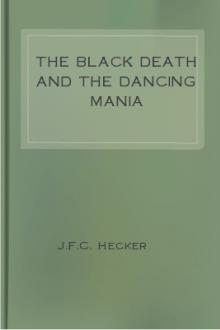The Black Death and The Dancing Mania, J. F. C. Hecker [digital ebook reader .TXT] 📗

- Author: J. F. C. Hecker
- Performer: -
Book online «The Black Death and The Dancing Mania, J. F. C. Hecker [digital ebook reader .TXT] 📗». Author J. F. C. Hecker
No power of medicine brought relief—almost all died within the first three days, some sooner, some later, after the appearance of these signs, and for the most part entirely without fever or other symptoms. The plague spread itself with the greater fury, as it communicated from the sick to the healthy, like fire among dry and oily fuel, and even contact with the clothes and other articles which had been used by the infected, seemed to induce the disease.
As it advanced, not only men, but animals fell sick and shortly expired, if they had touched things belonging to the diseased or dead. Thus Boccacio himself saw two hogs on the rags of a person who had died of plague, after staggering about for a short time, fall down dead as if they had taken poison. In other places multitudes of dogs, cats, fowls, and other animals, fell victims to the contagion; and it is to be presumed that other epizootes among animals likewise took place, although the ignorant writers of the fourteenth century are silent on this point.
In Germany there was a repetition in every respect of the same phenomena. The infallible signs of the oriental bubo-plague with its inevitable contagion were found there as everywhere else; but the mortality was not nearly so great as in the other parts of Europe. The accounts do not all make mention of the spitting of blood, the diagnostic symptom of this fatal pestilence; we are not, however, thence to conclude that there was any considerable mitigation or modification of the disease, for we must not only take into account the defectiveness of the chronicles, but that isolated testimonies are often contradicted by many others. Thus the chronicles of Strasburg, which only take notice of boils and glandular swellings in the axillae and groins, are opposed by another account, according to which the mortal spitting of blood was met with in Germany; but this again is rendered suspicious, as the narrator postpones the death of those who were thus affected, to the sixth, and (even the) eighth day, whereas, no other author sanctions so long a course of the disease; and even in Strasburg, where a mitigation of the plague may, with most probability, be assumed since the year 1349, only 16,000 people were carried off, the generality expired by the third or fourth day. In Austria, and especially in Vienna, the plague was fully as malignant as anywhere, so that the patients who had red spots and black boils, as well as those afflicted with tumid glands, died about the third day; and lastly, very frequent sudden deaths occurred on the coasts of the North Sea and in Westphalia, without any further development of the malady.
To France, this plague came in a northern direction from Avignon, and was there more destructive than in Germany, so that in many places not more than two in twenty of the inhabitants survived.
Many were struck, as if by lightning, and died on the spot, and this more frequently among the young and strong than the old; patients with enlarged glands in the axillae and groins scarcely survive two or three days; and no sooner did these fatal signs appear, than they bid adieu to the world, and sought consolation only in the absolution which Pope Clement VI. promised them in the hour of death.
In England the malady appeared, as at Avignon, with spitting of blood, and with the same fatality, so that the sick who were afflicted either with this symptom or with vomiting of blood, died in some cases immediately, in others within twelve hours, or at the latest two days. The inflammatory boils and buboes in the groins and axillae were recognised at once as prognosticating a fatal issue, and those were past all hope of recovery in whom they arose in numbers all over the body. It was not till towards the close of the plague that they ventured to open, by incision, these hard and dry boils, when matter flowed from them in small quantity, and thus, by compelling nature to a critical suppuration, many patients were saved. Every spot which the sick had touched, their breath, their clothes, spread the contagion; and, as in all other places, the attendants and friends who were either blind to their danger, or heroically despised it, fell a sacrifice to their sympathy. Even the eyes of the patient were considered a sources of contagion, which had the power of acting at a distance, whether on account of their unwonted lustre, or the distortion which they always suffer in plague, or whether in conformity with an ancient notion, according to which the sight was considered as the bearer of a demoniacal enchantment. Flight from infected cities seldom availed the fearful, for the germ of the disease adhered to them, and they fell sick, remote from assistance, in the solitude of their country houses.
Thus did the plague spread over England with unexampled rapidity, after it had first broken out in the county of Dorset, whence it advanced through the counties of Devon and Somerset, to Bristol, and thence reached Gloucester, Oxford and London. Probably few places escaped, perhaps not any; for the annuals of contemporaries report that throughout the land only a tenth part of the inhabitants remained alive.
From England the contagion was carried by a ship to Bergen, the capital of Norway, where the plague then broke out in its most frightful form, with vomiting of blood; and throughout the whole country, spared not more than a third of the inhabitants. The sailors found no refuge in their ships; and vessels were often seen driving about on the ocean and drifting on shore, whose crews had perished to the last man.
In Poland the affected were attacked with spitting blood, and died in a few days in such vast numbers, that, as it has been affirmed, scarcely a fourth of the inhabitants were left.
Finally, in Russia the plague appeared two years later than in Southern Europe; yet here again, with the same symptoms as elsewhere. Russian contemporaries have recorded that it began with rigor, heat, and darting pain in the shoulders and back; that it was accompanied by spitting of blood, and terminated fatally in two, or at most three days. It is not till the year 1360 that we find buboes mentioned as occurring in the neck, in the axillae, and in the groins, which are stated to have broken out when the spitting of blood had continued some time. According to the experience of Western Europe, however, it cannot be assumed that these symptoms did not appear at an earlier period.
Thus much, from authentic sources, on the nature of the Black Death. The descriptions which have been communicated contain, with a few unimportant exceptions, all the symptoms of the oriental plague which have been observed in more modern times. No doubt can obtain on this point. The facts are placed clearly before our eyes. We must, however, bear in mind that this violent disease does not always appear in the same form, and that while the essence of the poison which it produces, and which is separated so abundantly from the body of the patient, remains unchanged, it is proteiform in its varieties, from the almost imperceptible vesicle, unaccompanied by fever, which exists for some time before it extends its poison inwardly, and then excites fever and buboes, to the fatal form in which carbuncular inflammations fall upon the most important viscera.
Such was the form which the plague assumed in the fourteenth century, for the accompanying chest affection which appeared in all the countries whereof we have received any account, cannot, on a comparison with similar and familiar symptoms, be considered as any other than the inflammation of the lungs of modern medicine, a disease which at present only appears sporadically, and, owing to a putrid decomposition of the fluids, is probably combined with hemorrhages from the vessels of the lungs. Now, as every carbuncle, whether it be cutaneous or internal, generates in abundance the matter of contagion which has given rise to it, so, therefore, must the breath of the affected have been poisonous in this plague, and on this account its power of contagion wonderfully increased; wherefore the opinion appears incontrovertible, that owing to the accumulated numbers of the diseased, not only individual chambers and houses, but whole cities were infected, which, moreover, in the Middle Ages, were, with few exceptions, narrowly built, kept in a filthy state, and surrounded with stagnant ditches. Flight was, in consequence, of no avail to the timid; for even though they had sedulously avoided all communication with the diseased and the suspected, yet their clothes were saturated with the pestiferous atmosphere, and every inspiration imparted to them the seeds of the destructive malady, which, in the greater number of cases, germinated with but too much fertility. Add to which, the usual propagation of the plague through clothes, beds, and a thousand other things to which the pestilential poison adheres—a propagation which, from want of caution, must have been infinitely multiplied; and since articles of this kind, removed from the access of air, not only retain the matter of contagion for an indefinite period, but also increase its activity and engender it like a living being, frightful ill-consequences followed for many years after the first fury of the pestilence was past.
The affection of the stomach, often mentioned in vague terms, and occasionally as a vomiting of blood, was doubtless only a subordinate symptom, even if it be admitted that actual hematemesis did occur. For the difficulty of distinguishing a flow of blood from the stomach, from a pulmonic expectoration of that fluid, is, to non-medical men, even in common cases, not inconsiderable. How much greater then must it have been in so terrible a disease, where assistants could not venture to approach the sick without exposing themselves to certain death? Only two medical descriptions of the malady have reached us, the one by the brave Guy de Chauliac, the other by Raymond Chalin de Vinario, a very experienced scholar, who was well versed in the learning of the time. The former takes notice only of fatal coughing of blood; the latter, besides this, notices epistaxis, hematuria, and fluxes of blood from the bowels, as symptoms of such decided and speedy mortality, that those patients in whom they were observed usually died on the same or the following day.
That a vomiting of blood may not, here and there, have taken place, perhaps have been even prevalent in many places, is, from a consideration of the nature of the disease, by no means to be denied; for every putrid decomposition of the fluids begets a tendency to hemorrhages of all kinds. Here, however, it is a question of historical certainty, which, after these doubts, is by no means established. Had not so speedy a death followed the expectoration of blood, we should certainly have received more detailed intelligence respecting other hemorrhages; but the malady had no time to extend its effects further over the extremities of the vessels. After its first fury, however, was spent, the pestilence passed into the usual febrile form of the oriental plague. Internal





Comments (0)